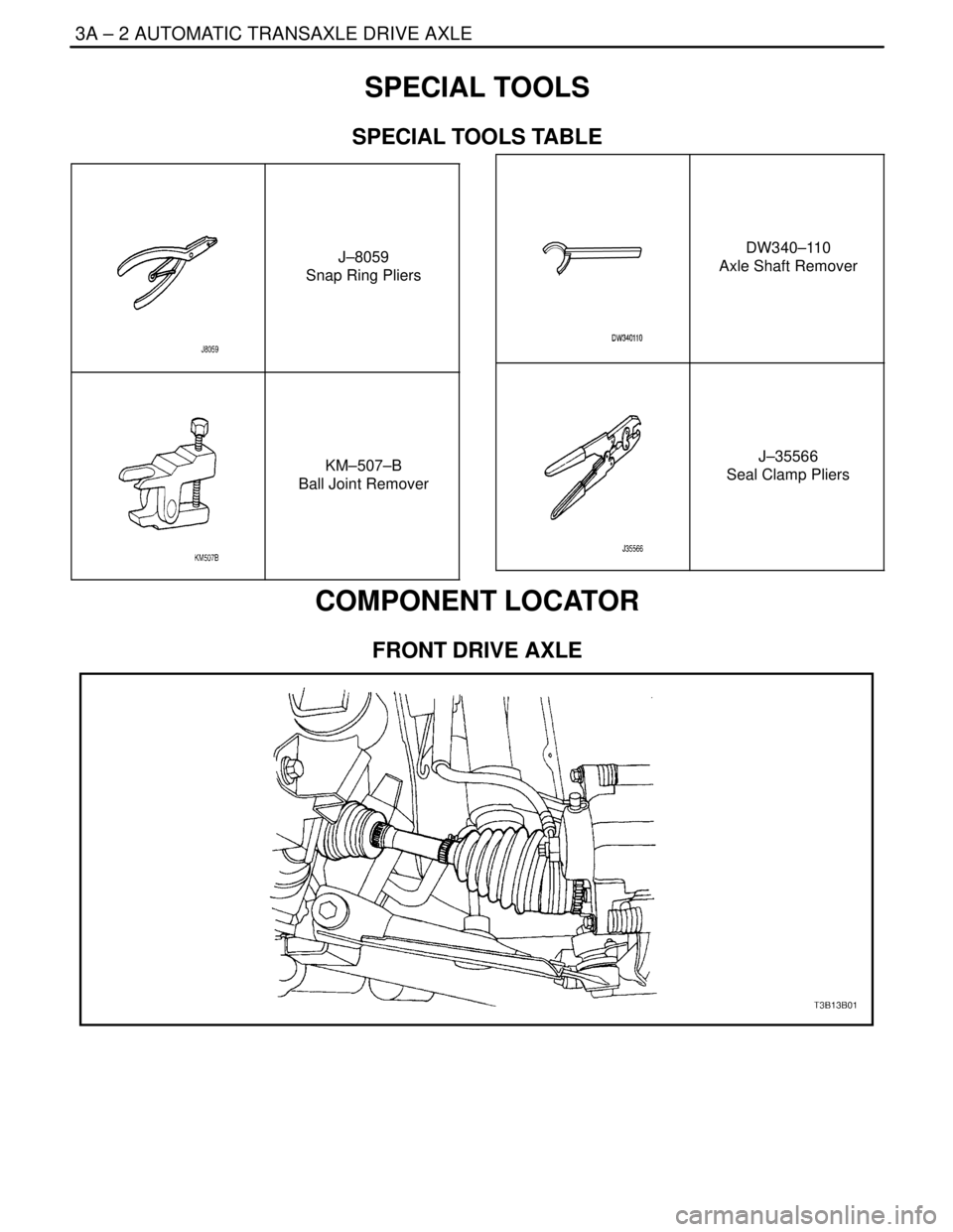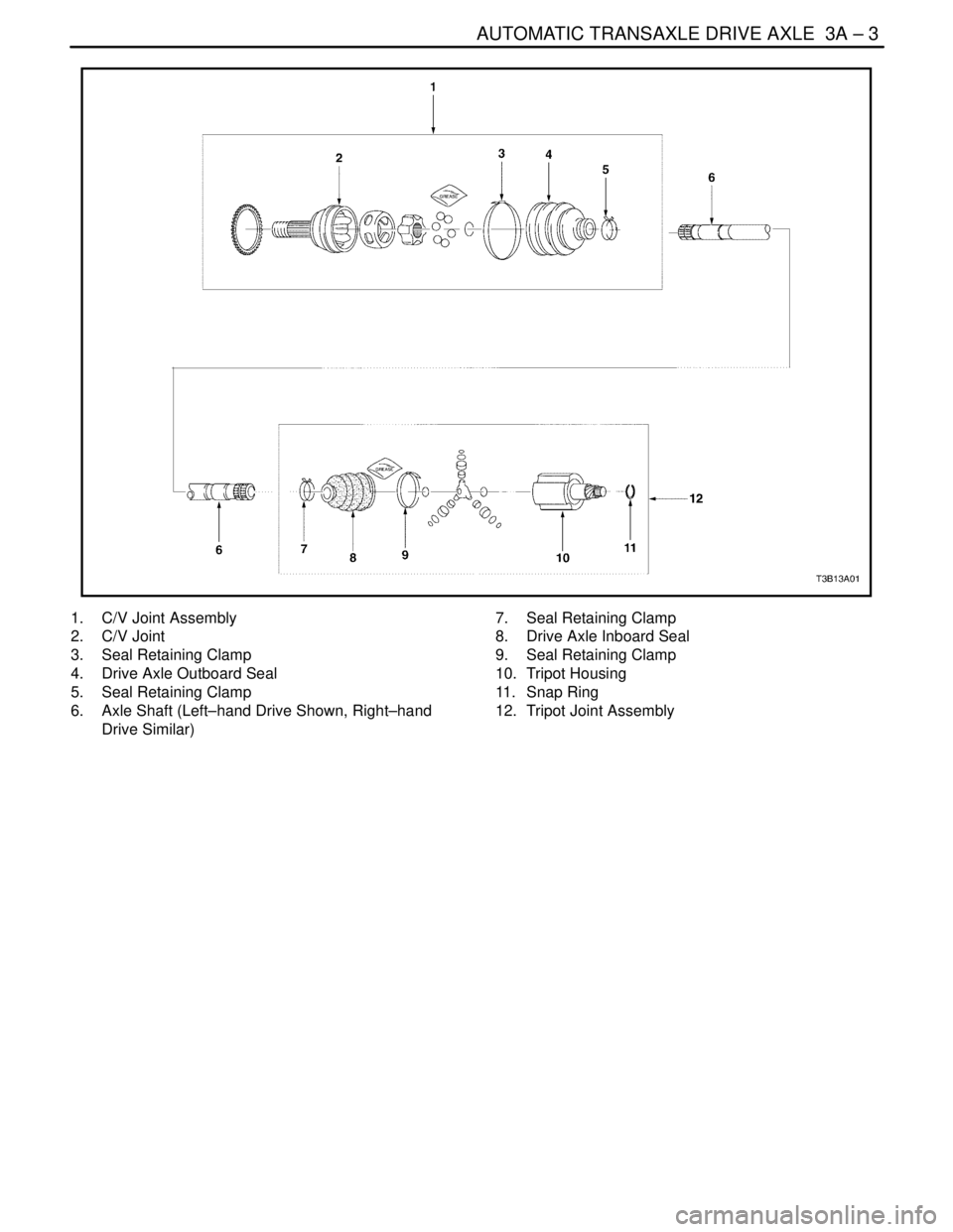2004 DAEWOO NUBIRA automatic transaxle
[x] Cancel search: automatic transaxlePage 872 of 2643

1F – 626IENGINE CONTROLS
DAEWOO V–121 BL4
EXHAUST GAS RECIRCULATION
VA LV E
The Exhaust Gas Recirculation (EGR) system is used on
engines equipped with an automatic transaxle to lower
NOx (oxides of nitrogen) emission levels caused by high
combustion temperature. The EGR valve is controlled by
the engine control module (ECM). The EGR valve feeds
small amounts of exhaust gas into the intake manifold to
decrease combustion temperature. The amount of ex-
haust gas recirculated is controlled by variations in vacu-
um and exhaust back pressure. If too much exhaust gas
enters, combustion will not take place. For this reason,
very little exhaust gas is allowed to pass through the valve,
especially at idle.
The EGR valve is usually open under the following condi-
tions:
S Warm engine operation.
S Above idle speed.
Results of Incorrect Operation
Too much EGR flow tends to weaken combustion, causing
the engine to run roughly or to stop. With too much EGR
flow at idle, cruise, or cold operation, any of the following
conditions may occur:
S The engine stops after a cold start.
S The engine stops at idle after deceleration.
S The vehicle surges during cruise.
S Rough idle.
If the EGR valve stays open all the time, the engine may
not idle. Too little or no EGR flow allows combustion tem-
peratures to get too high during acceleration and load con-
ditions. This could cause the following conditions:
S Spark knock (detonation)
S Engine overheating
S Emission test failure
INTAKE AIR TEMPERATURE
SENSOR
The Intake Air Temperature (IAT) sensor is a thermistor,
a resistor which changes value based on the temperature
of the air entering the engine. Low temperature produces
a high resistance (4,500 ohms at –40°F [–40°C]), while
high temperature causes a low resistance (70 ohms at
266°F [130°C]).
The engine control module (ECM) provides 5 volts to the
IAT sensor through a resistor in the ECM and measures
the change in voltage to determine the IAT. The voltage will
be high when the manifold air is cold and low when the air
is hot. The ECM knows the intake IAT by measuring the
voltage.
The IAT sensor is also used to control spark timing when
the manifold air is cold.
A failure in the IAT sensor circuit sets a diagnostic trouble
code P0112 or P0113.
IDLE AIR CONTROL VALVE
Notice : Do not attempt to remove the protective cap to
readjust the stop screw. Misadjustment may result in dam-
age to the Idle Air Control (IAC) valve or to the throttle
body.
The IAC valve is mounted on the throttle body where it
controls the engine idle speed under the command of the
engine control module (ECM). The ECM sends voltage
pulses to the IAC valve motor windings, causing the IAC
valve pintle to move in or out a given distance (a step or
count) for each pulse. The pintle movement controls the
airflow around the throttle valves which, in turn, control the
engine idle speed.
The desired idle speeds for all engine operating conditions
are programmed into the calibration of the ECM. These
programmed engine speeds are based on the coolant
temperature, the park/neutral position switch status, the
vehicle speed, the battery voltage, and the A/C system
pressure (if equipped).
The ECM ”learns” the proper IAC valve positions to
achieve warm, stabilized idle speeds (rpm) desired for the
various conditions (park/neutral or drive, A/C on or off, if
equipped). This information is stored in ECM ”keep alive”
memories. Information is retained after the ignition is
turned OFF. All other IAC valve positioning is calculated
based on these memory values. As a result, engine varia-
tions due to wear and variations in the minimum throttle
valve position (within limits) do not affect engine idle
speeds. This system provides correct idle control under all
conditions. This also means that disconnecting power to
the ECM can result in incorrect idle control or the necessity
to partially press the accelerator when starting until the
ECM relearns idle control.
Engine idle speed is a function of total airflow into the en-
gine based on the IAC valve pintle position, the throttle
valve opening, and the calibrated vacuum loss through ac-
cessories. The minimum throttle valve position is set at the
factory with a stop screw. This setting allows enough air-
flow by the throttle valve to cause the IAC valve pintle to
be positioned a calibrated number of steps (counts) from
the seat during ”controlled” idle operation. The minimum
throttle valve position setting on this engine should not be
considered the ”minimum idle speed,” as on other fuel in-
jected engines. The throttle stop screw is covered with a
plug at the factory following adjustment.
If the IAC valve is suspected as the cause of improper idle
speed, refer to ”Idle Air Control System Check” in this sec-
tion.
MANIFOLD ABSOLUTE PRESSURE
SENSOR
The Manifold Absolute Pressure (MAP) sensor measures
the changes in the intake manifold pressure which result
from engine load and speed changes. It converts these to
a voltage output.
Page 990 of 2643

SECTION : 3A
AUTOMATIC TRANSAXLE DRIVE AXLE
TABLE OF CONTENTS
SPECIFICATIONS3A–1 . . . . . . . . . . . . . . . . . . . . . . . . . .
Fastener Tightening Specifications 3A–1. . . . . . . . . .
SPECIAL TOOLS3A–2 . . . . . . . . . . . . . . . . . . . . . . . . . . .
Special Tools Table 3A–2. . . . . . . . . . . . . . . . . . . . . . . .
COMPONENT LOCATOR3A–2 . . . . . . . . . . . . . . . . . . . .
Front Drive Axle 3A–2. . . . . . . . . . . . . . . . . . . . . . . . . .
MAINTENANCE AND REPAIR3A–4 . . . . . . . . . . . . . . . ON–VEHICLE SERVICE 3A–4. . . . . . . . . . . . . . . . . . . . .
Drive Axle Assembly 3A–4. . . . . . . . . . . . . . . . . . . . . . .
UNIT REPAIR 3A–7. . . . . . . . . . . . . . . . . . . . . . . . . . . . . .
Outer Joint Seal 3A–7. . . . . . . . . . . . . . . . . . . . . . . . . .
Inner Tripot Seal 3A–8. . . . . . . . . . . . . . . . . . . . . . . . . .
GENERAL DESCRIPTION AND SYSTEM
OPERATION3A–10 . . . . . . . . . . . . . . . . . . . . . . . . . . . . .
Front Drive Axle 3A–10. . . . . . . . . . . . . . . . . . . . . . . . . .
SPECIFICATIONS
FASTENER TIGHTENING SPECIFICATIONS
ApplicationNSmLb–FtLb–In
Axle Shaft Caulking Nut300221–
Lower Ball Joint Pinch Bolt and Nut6044–
Tie Rod Nut5541–
Wheel Nuts10074–
Page 991 of 2643

3A – 2IAUTOMATIC TRANSAXLE DRIVE AXLE
DAEWOO V–121 BL4
SPECIAL TOOLS
SPECIAL TOOLS TABLE
J–8059
Snap Ring Pliers
KM–507–B
Ball Joint Remover
DW340–110
Axle Shaft Remover
J–35566
Seal Clamp Pliers
COMPONENT LOCATOR
FRONT DRIVE AXLE
Page 992 of 2643

AUTOMATIC TRANSAXLE DRIVE AXLE 3A – 3
DAEWOO V–121 BL4
1. C/V Joint Assembly
2. C/V Joint
3. Seal Retaining Clamp
4. Drive Axle Outboard Seal
5. Seal Retaining Clamp
6. Axle Shaft (Left–hand Drive Shown, Right–hand
Drive Similar)7. Seal Retaining Clamp
8. Drive Axle Inboard Seal
9. Seal Retaining Clamp
10. Tripot Housing
11. Snap Ring
12. Tripot Joint Assembly
Page 993 of 2643

3A – 4IAUTOMATIC TRANSAXLE DRIVE AXLE
DAEWOO V–121 BL4
MAINTENANCE AND REPAIR
ON–VEHICLE SERVICE
DRIVE AXLE ASSEMBLY
Tools Required
KM–507–B Ball Joint Separator
DW340–110 Axle Shaft Remover
Removal Procedure
1. Raise and suitably support the vehicle.
2. Remove the wheels. Refer to Section 2E, Tires
and Wheels.
3. Remove the axle shaft caulking nut. Discard the
nut.
Notice : Use only the recommended tool for separating
the lower ball joint. Failure to use the recommended tool
may cause damage to the ball joint and the seal.
4. Remove the lower ball joint pinch bolt and nut.
5. Separate the steering knuckle from the lower ball
joint using the ball joint separator KM–507–B.
6. Remove the tie rod nut.
Notice : Use only the recommended tool for separating
the tie rod from the knuckle/strut assembly. Failure to use
the recommended tool may cause damage to the knuckle/
strut assembly.
7. Separate the tie rod end using the ball joint separa-
tor KM–507–B.
Page 994 of 2643

AUTOMATIC TRANSAXLE DRIVE AXLE 3A – 5
DAEWOO V–121 BL4
8. Remove the damping block connection nut and
bolt.
9. Remove the rear mounting bracket bolts and the
bracket.
10. Push the drive axle shaft from the wheel hub.
Important : Support the unfastened end of the drive axle.
Do not allow the drive axle to dangle freely from the trans-
axle for any length of time after it has been removed from
the wheel hub.
Important : Place a drain pan below the transaxle to catch
the escaping fluid. Cap the transaxle drive opening after
the drive axle has been removed to keep the fluid in and
any contamination out.
11. Remove the drive axle from the transaxle using the
axle shaft remover DW340–110.
Installation Procedure
Notice : Do not damage the seals.
1. Clean the hub seal and the transaxle seal.
2. Install the drive axle into the transaxle.
3. Install the wheel hub onto the axle shaft.
4. Install the rear mounting bracket bolts and the bra-
ket.
Tighten
Tighten the rear mounting bracket bolts to 62 NSm (45
lb–ft).
5. Install the damping block connection nut and bolt.
Tighten
Tighten the damping block connection nut and bolt to
68 NSm (50 lb–ft).
Page 995 of 2643

3A – 6IAUTOMATIC TRANSAXLE DRIVE AXLE
DAEWOO V–121 BL4
6. Install the tie rod into the knuckle/strut and install
the tie rod nut.
Tighten
Tighten the tie rod nut to 55 NSm (41 lb–ft).
7. Install the lower ball joint pinch bolt and nut.
Tighten
Tighten the lower ball joint pinch bolt and nut to 60
NSm (44 lb–ft).
8. Loosely install a new axle shaft caulking nut. Al-
ways use a new nut.
9. Install the wheels. Loosely install the nuts. Refer to
Section 2E, Tires and Wheels.
10. Lower the vehicle to the floor.
Tighten
Tighten the wheel nuts to 100 NSm (74 lb–ft).
11. Tighten the axle shaft caulking nut to 300 NSm (221
lb–ft).
12. Peen the caulking nut with a punch and a hammer
until the nut is locked into place on the axle shaft
hub.
13. Refill the transaxle fluid to the proper level. Refer to
Section 5A, ZF 4HP 16 Automatic Transaxle.
Page 996 of 2643

AUTOMATIC TRANSAXLE DRIVE AXLE 3A – 7
DAEWOO V–121 BL4
UNIT REPAIR
OUTER JOINT SEAL
Tools Required
J–8059 Snap Ring Pliers
J–35566 Seal Clamp Pliers
Removal Procedure
1. Remove the drive axle from the vehicle. Refer to
”Drive Axle Assembly” in this section.
2. Remove the large seal retaining clamp. Discard the
clamp.
3. Remove the small seal retaining clamp. Discard the
clamp.
4. Degrease the joint.
5. Spread the snap ring using the snap ring pliers
J–8059 and remove the outer joint the axle shaft.
CAUTION : Do not disassemble the outer joint assem-
bly. Parts are match fit and cannot be serviced sepa-
rately. Improper reassembly will adversely affect both
performance and safety.
6. Remove the seal from the joint assembly.
Installation Procedure
1. Install the seal onto the axle shaft.
2. Spread the snap ring using the snap ring pliers
J–8059 and remove the outer joint the axle shaft.
3. Fill the joint seal with 120 to 140 g (4.2 to 4.9
ounces) of the recommended grease. Repack the
joint with 120 to 140 g (4.2 to 4.9 ounces) of the
recommended grease.
4. Install a new large seal retaining clamp and a new
small seal retaining clamp.
5. Crimp the new small seal retaining clamp and the
new large seal retaining clamp using the seal clamp
pliers J–35566.
6. Install the drive axle shaft to the vehicle. Refer to
”Drive Axle Assembly”in this section.